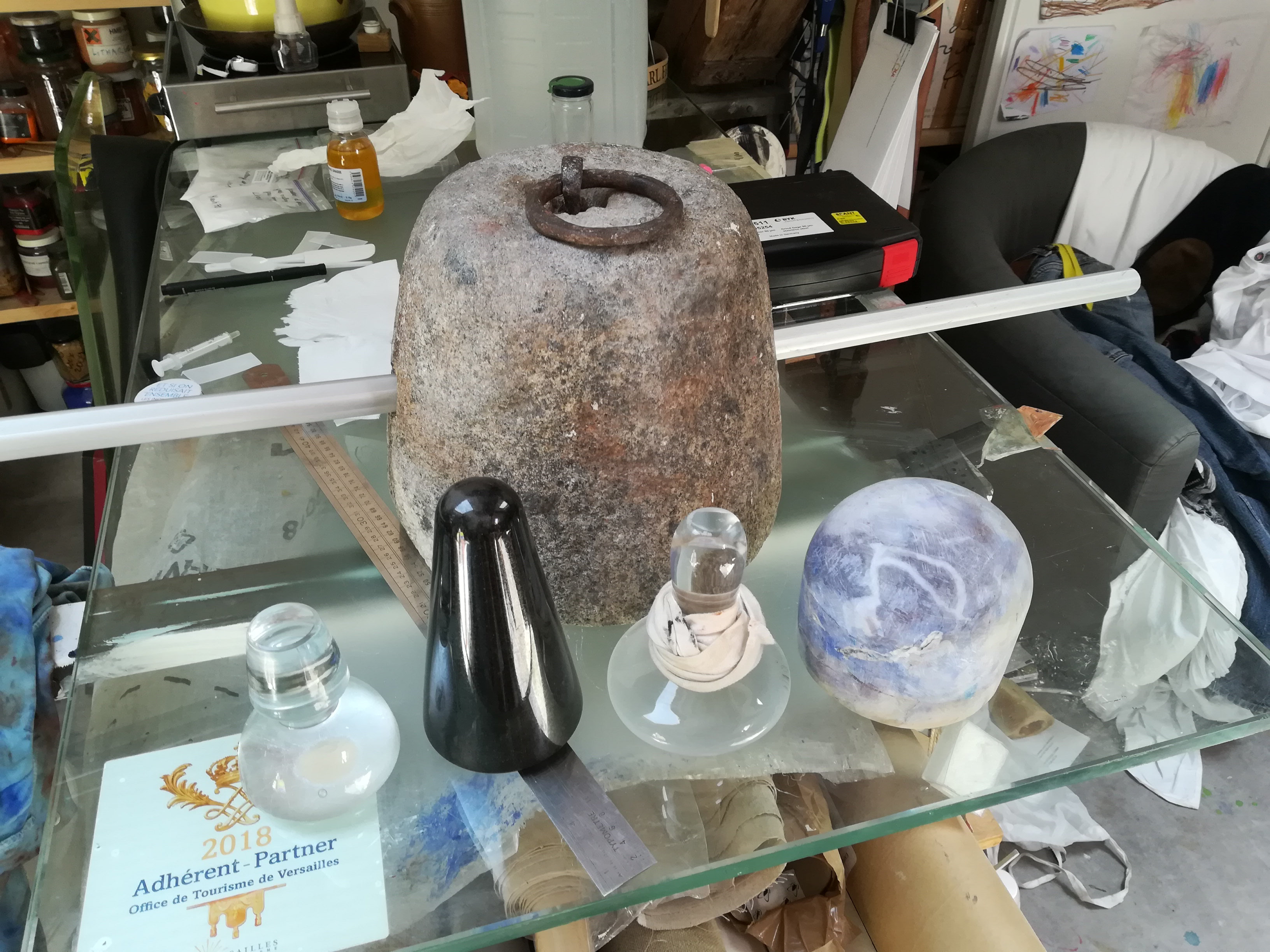Home › Forums › Explore Media › Oil Painting › The Technical Forum › Have you used more than one size of muller?
- This topic has 13 replies, 5 voices, and was last updated 5 years, 9 months ago by
 kentiessen.
kentiessen.
-
AuthorPosts
-
June 3, 2018 at 5:19 pm #456979
I am looking for some feedback from anyone here on WC who has used more than one size of paint muller. I have only used a tiny 1″ muller and palette knives to mull paint but I now need to make larger batches. I have read where some people prefer what seems to me like a fairly small muller – about 2″ diameter – over larger ones, saying they are easier to apply more pressure than a big muller.
I can see how a smallish one would be easier for small batches but how small to go for mixing 150 to 300 ml of paint at a time? I know I don’t want a large one. 3″ to 3.5″ would be as big as I would likely go.
Please post your thoughts / comments.
Thanks!
——————
The information from the link below has influenced my leaning towards a smaller muller.
http://artemisglass.bz/mullers/[INDENT]
[FONT=Arial, Helvetica, sans-serif]A word about using a muller and grinding[/FONT][FONT=Arial, Helvetica, sans-serif]Mullers are used by all artist needing to grind their own pigments including fresco painters, stain glass painters, oil painters, tempera painters and more. It is the perfect addition to your artist’s tool kit.[/FONT][FONT=Arial, Helvetica, sans-serif]Use mullers on a slab of marble or granite (ideally porphyry) or a thick sheet of glass to grind and disperse pigments and other materials into paint medium. Both surfaces of the muller and the grinding slab can be retextured periodically after use with a slurry of water and 100 grit silicon carbide although 80-grit carborundum paper is sufficient for most users.[/FONT][FONT=Arial, Helvetica, sans-serif]To disperse pigments in paint medium, place a small quantity of powdered pigment on the grinding surface and work in oil or water a little at a time with a spatula until a stiff paste is formed. Begin grinding the paste in circular or figure 8 motions until the paste has a smooth consistency. It is not necessary to bear down with your weight on the muller since the idea here is to disperse, rather than to grind the pigment.[/FONT][FONT=Arial, Helvetica, sans-serif]Some artists insist that a heavy, six-inch muller can only be effective. I fully understand that it is good to use a technique you are used to however, it is also good to be aware of other techniques 🙂[/FONT][FONT=Arial, Helvetica, sans-serif]Hence I use a small muler, which is quite adequate I find. Although a ten pound weight pressing down on a six inch diameter muller equates to 0.4 pounds per square inch, the same ten pounds pressure applied to a one and a half inch muller equals 5.6 pounds per square inch.[/FONT][FONT=Arial, Helvetica, sans-serif]Also consider the wastage of paint lost in cleaning a big muller. The glass plate that I mix paint on for stained glass painting is only eight inches square, that’s all I need.[/FONT][FONT=Arial, Helvetica, sans-serif]I think it may also be worth mentioning that one of the greatest assets to mulling paint, is the surface tension of the muller in the actual pigment. If it is kept perfectly square and flat during the mulling proccess, the force that is acquired by surface tension alone, is enough to offset using a small as opposed to a large muller. It does need practice as I found.[/FONT][FONT=Arial, Helvetica, sans-serif]Getting the heaviest muller possible isn’t necessary; keep in mind that while grinding the aim is to achieve a shearing force, which requires lateral movement rather than downward pressure. Use your strength to grind across the grinding surface rather than applying downward force.[/FONT][FONT=Arial, Helvetica, sans-serif]Get in the practice of using a hard rubber or plastic spatula to scrape the surface and collect the paint into a pile. The iron in steel spatulas may react with certain pigments, such as sulfide pigments. You can always use a steel spatula for clean up.[/FONT][/INDENT]
June 3, 2018 at 6:29 pm #634653I too read about a muller’s shearing action being what makes it work, not weight or pressure, so I was considering getting a medium-sized one–3″ in fact:
http://www.art-boards.com/Muller’s.htmhttps://www.haroldroth.com/
https://www.instagram.com/haroldrothart
https://www.facebook.com/haroldrothartistJune 4, 2018 at 7:02 am #634658Contamacous
 Hi , Thanks for posting this as am in process of purchasing such a tool as we speak and was wondering about such things:)
Hi , Thanks for posting this as am in process of purchasing such a tool as we speak and was wondering about such things:) I am not much to comment on such matters but i always figure when there is an expensive tool to be bought (ie especialy when you have to purchase the slab as well as the grinder ..for me as they don’t produce the glass slab in this country only the damn muller)
but i figure it will be horses for courses with this one ..you will just have to bite the bullet and go larger to try and if not sell the tool
Sculpture is what you bump into when you back up to see a painting..Barnett Newman
June 4, 2018 at 11:41 am #634656I have a marble tile from the lumber yard as my slab, tidal.
hobbyist in oil.
June 5, 2018 at 4:39 am #634659Thankyou p nathan
 though marble not sure would glass not be better due to it being colourless not sure about the marble afecting the pigment somehow
though marble not sure would glass not be better due to it being colourless not sure about the marble afecting the pigment somehowSculpture is what you bump into when you back up to see a painting..Barnett Newman
June 9, 2018 at 12:55 am #634657Contamacous
 Hi , Thanks for posting this as am in process of purchasing such a tool as we speak and was wondering about such things:)
Hi , Thanks for posting this as am in process of purchasing such a tool as we speak and was wondering about such things:) I am not much to comment on such matters but i always figure when there is an expensive tool to be bought (ie especialy when you have to purchase the slab as well as the grinder ..for me as they don’t produce the glass slab in this country only the damn muller)
but i figure it will be horses for courses with this one ..you will just have to bite the bullet and go larger to try and if not sell the tool
You are welcome. I use a sheet of regular 3/8″ thick glass procured at the local glass shop that has been ground with carborundum grit . You need to regrind the muller and glass plate from time to time anyway. One benefit to a small muller is you don’t need a large plate. An 8×8 plate should work fine with a 2″ muller. For the amount of mulling I do, glass is a requirement. Marble is too soft.
June 9, 2018 at 4:30 am #634660yes seems most won’t go beyond a certain thickness but I will ask around much apreciated you letting me know hope you resolved your muller issue

Sculpture is what you bump into when you back up to see a painting..Barnett Newman
July 2, 2018 at 9:57 am #634649The big granite muller with aluminium handle is 25cm working diameter.
The four ones in front of the slab are made of marble (10,5cm), glass (9cm), black granite (7,5) and crystal (7cm). The outer size of each muller is a little bigger than the working flat face, due to rounded edges of these tools.
 July 2, 2018 at 10:07 am #634650
July 2, 2018 at 10:07 am #634650I’m sorry, I still don’t know how to resize images hosted by zupimages…
July 2, 2018 at 9:03 pm #634654French, is that cone-shaped muller, the black one, easier on your hands?
https://www.haroldroth.com/
https://www.instagram.com/haroldrothart
https://www.facebook.com/haroldrothartistJuly 3, 2018 at 1:51 am #634651No. The best is the marble dome, because you can lean comfortably both hand on it, like on the David Ryckaert’s studio exhibited in the Louvre museum. When grinding color all day long, it is the less tiring position.
July 3, 2018 at 6:40 am #634655July 5, 2018 at 12:20 pm #634661that is interesting about the marble muller have to check that out.A word of warning about granite muller actualy don’t go for that in a slab or muller as granite can be pourous
Sculpture is what you bump into when you back up to see a painting..Barnett Newman
July 5, 2018 at 6:02 pm #634652These ones are OK. I don’t have any staining issue due to residual color left in porous parts of the stone.
I clean thoroughly the muller after grinding session. Even with Prussian blue or dioxazine, everything is OK if I grind white paint. But I spend a lot of time cleaning my tools. -
AuthorPosts
- You must be logged in to reply to this topic.
Register For This Site
A password will be e-mailed to you.
Search